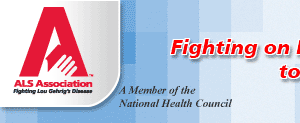

 |
 |
|
May 1, 2008 Drug Company Working Group Focuses on New ALS Therapies Ideas for new ALS treatments come from many different sources. That was the message from The ALS Association’s Drug Company Working Group meeting held in Chicago in April, at the kick-off of the Annual Meeting of the American Academy of Neurology. The research meeting was sponsored by The ALS Association. The ALS Association established the Drug Company Working Group to promote ALS treatment development by bringing together leaders from throughout the ALS community, including clinicians and researchers, representatives from academia and industry, as well as those from government agencies, such as the National Institutes of Health. “Clinical trials in ALS are the ultimate goal of all research in ALS, but the road to the clinic starts at the lab bench,” according to Lucie Bruijn, Ph.D., science director and vice president of The Association. “Basic biology is the source for new therapeutic ideas. These are the clues that show us how to develop new treatments.” Rebecca Pruss, Ph.D., of Trophos, a biotechnology company dedicated to finding treatments for neurologic diseases, presented results from a high-throughput screen in motor neurons (the cells that die in ALS). The company has identified a new molecule, similar to cholesterol, that improves survival in cells by promoting the function of mitochondria, the cell's powerhouses. “Mitochondria are the central integrators of survival and death in cells,” Dr. Pruss said. A safety study of the compound has been completed in a small number of ALS patients, and a larger clinical trial is planned for 2009. Another experimental treatment is being developed by Phytopharm, a company specializing in medicines derived from plants, including many identified from Chinese herbal medicine. One, prepared from yucca and yams, is used in China to enhance memory and muscle coordination. Phytopharm has found that a compound from these plants stimulates production of growth factors. Growth factors are critical for the survival of motor neurons and increase the growth of their long extensions, called axons, which control muscles. In cells, the plant-derived compound can reverse the damage from too much excitation (a process implicated in ALS), and in mice, it can extend survival about 10%. A clinical trial in ALS patients is planned for later this year. One treatment discussed at the meeting is already widely used in Europe, and is currently being studied in 74 patients in the U.S. Called diaphragm pacing stimulation (DPS), the technique implants electrodes in the diaphragm, the muscle at the base of the chest cavity that is largely responsible for breathing. The diaphragm normally contracts steadily and rhythmically, but as ALS progresses, its contractions can become intermittent (see related story). A standard treatment has been the use of noninvasive ventilation (BiPAP), which takes over the work of the diaphragm, but recent studies have shown this hastens the weakening of the muscle. The goal of DPS is to keep the diaphragm working on its own, avoiding this problem. By delivering small pulses of electricity several times a day, DPS maintains a more normal rhythm. "We think we can help maintain the diaphragm’s strength a little more," said Raymond Onders, M.D., of Case Western Reserve University. He noted that DPS is only effective for breathing, and does not change the course of the disease, but weakness of the breathing muscles is a key factor in decline of health in an ALS patient. That basic research is conducted most often in model systems, designed to mimic some aspect of the disease process. There is a wide range of experimental models for ALS, from cells in a dish to nematodes to mice. Each has its advantages, according to Ray Roos, M.D., of the University of Chicago. Most current models rely on mutations in the SOD1 gene to induce ALS-like changes. While such mutations are responsible for only 2-4% of all cases ALS, results from these models may provide insight into other forms of the disease, Dr. Roos thinks, since all forms of ALS may share a “final common pathway,” though they start from different points. Cell cultures are particularly good for “high throughput” drug discovery, since thousands of compounds can be screened very quickly by automated systems. Such a screen was responsible for identifying a promising drug candidate now in clinical trials, the antibiotic ceftriaxone. Microscopic nematodes are the simplest of animal models, and their genetic makeup and development are well characterized, so that the effects of either disease genes or drugs can be better understood. Mice have a complex mammalian nervous system, providing researchers an important way to test the effects of treatments in an organism similar to humans. The Drug Company Working Group meeting is coordinated by the Advocacy, Research and Patient Services departments of The Association, and presents a unique opportunity for the ALS community not only to discuss the status of basic and clinical research in ALS, but also to identify the challenges, obstacles and opportunities that are available to bring promising new research from the lab to the bedside. Indeed, one of the priorities of the Drug Company Working Group is to accelerate the development of new treatments for ALS. Increasing the pace of development of new therapies is also the goal of The Association's TREAT ALS™ program. To move potential new treatments from the bench toward the bedside more rapidly requires coordinated clinical trials. This is the purpose of NEALS (Northeast ALS Consortium), a network of clinical researchers dedicated to working together to increase the number and quality of treatment trials in ALS. With funding from TREAT ALS, NEALS has improved its data acquisition and analysis capabilities. NEALS has also brought several young researchers into the network, who will play increasingly important roles in future research. Click here for a summary of research highlights from the full AAN meeting. |
|
| |||
The ALS Association �2004 The ALS Association. All rights reserved. Contact the Webmaster |